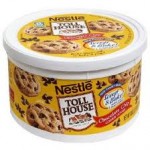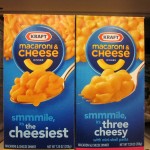This January we met our children and their significant others in Hawaii for a delayed Christmas vacation, primarily because Hawaii emerged as the midpoint of our scattered lives. Ned and Emily joined us from China, while Frances and Dan traveled from Seattle, and we arrived from Chicago. Nick and I looked forward to leaving mainland staples behind and sampling Polynesian food. To Ned and Emily, this was the first outpost of the United States, and they looked forward to a respite from the daily Chinese fare of stick food, duck tongue and various rodents. They reveled in an American supermarket, feasting their eyes on American comfort food – thick hamburgers and French fries and boxes of Kraft Macaroni and Cheese.
Kraft Macaroni and Cheese –that pasta that comes with powdered milk/cheese combo – how can that be a comfort food? What does that say about me as a parent? Shouldn’t a comfort food be a nostalgic reminder of a home-made favorite, touching all the key senses – sight, smell, taste and mouth feel? It is definitely true that our kids were served their share of processed mac ‘n cheese, typically something that I made in the last few minutes before the baby sitter came and we went out to dinner. I did feel a touch of guilt as I sprinkled in that bright orange radioactive powder, but perhaps I thought that at least I wasn’t serving them one of those wretched McDonald’s Happy Meals. And then I would take a bite of the mac ‘n cheese, and then another – it was actually not bad. Here I was about to go to someone’s house for dinner, someone who had probably spent a good part of the afternoon cooking a very fine meal, and I was snacking on shitty mac ‘n cheese. That was the guiltiest part of the whole experience.
This reminiscence made me consider the concept of comfort food and its role in our lives. Certainly, comfort food implies nostalgia, but there is another category of indulgent comfort food – the stereotypical pitiful woman sitting alone in her apartment after a painful break up, trying to comfort her broken heart with a tub of Hagen Daz ice cream. Then there is comfort food as a guilty pleasure – raw cookie dough comes to mind here. In fact, when we were in Hawaii, one of our first stops was Costco to stock on various provisions for our rented condo. Nick hid an enormous tub of Nestlé’s chocolate chip cookie dough in the basket. Everyone was slightly repulsed as we unpacked, and the tub clearly warns you not to be foolish and eat raw dough, but then everyone started to sneak little spoonfuls. I don’t think that I ever saw anyone eat it, but the entire tub was gone within a week. But nostalgia remains the primary role of comfort food, and in fact, comfort food is a generational marker – until you establish a household of your own, you are the recipient of comfort food, but then suddenly you become the comfort chef.
cookie dough in the basket. Everyone was slightly repulsed as we unpacked, and the tub clearly warns you not to be foolish and eat raw dough, but then everyone started to sneak little spoonfuls. I don’t think that I ever saw anyone eat it, but the entire tub was gone within a week. But nostalgia remains the primary role of comfort food, and in fact, comfort food is a generational marker – until you establish a household of your own, you are the recipient of comfort food, but then suddenly you become the comfort chef.
With the exception of chicken soup, comfort food is probably rich or creamy and loaded with calories. My mother cooked a special birthday meal on request and my brother always chose a favorite homemade macaroni and cheese that had a dash of curry in it, and some sort crusty cheese topping that you could sort of pick and peel away like a crunchy scab. So yummy. My comfort food has always been bacon, and my birthday request was a BLT. Since my mother knew that Dad would be not pleased with a sandwich for dinner, she baked an entire turkey to go with it so that I could make a club sandwich and the rest of the family could enjoy the comfort of a Thanksgiving dinner in May. Later on, my mother always had a pot of barley soup simmering on the stove when my family would visit on the weekends, and I know my children consider this a nostalgic comfort food.
Different cultures have different comfort foods. In Europe, it is typically some type of stew made from cheap cuts of meat that can be simmered for hours, filling the house with a defining aroma. In Asia, comfort foods are often based on rice, such as a congee or a jook consisting of rice that has been cooked for several hours in a large amount of water and turned into a glutinous porridge. Vegemite and Marmite are listed as comfort foods in England and Australia, respectively. These salty, yeasty sandwich spreads look like crankcase oil. They are universally detested outside these countries, which only makes Brits and Aussie more proud of their comfort food. I bought a jar of Marmite on Amazon just to see what the fuss was about, and my British friend Sarah cautioned me to use it very sparingly. A tiny taste with the tip of my pinky was enough to get a gist of the saltiness. Even if I could get used to it, my 4 ounce jar will be more than a life time supply.
“Toast” was also listed on Wikipedia as a British comfort food, which seemed entirely prosaic. However, Brits are supposed to get all misty eyed over something called “spotted dick,” a steamed pudding whose principle ingredients are “shredded suet” and currants.  The suet consists of the hard fat surrounding the kidneys, but when I think of suet, I only think of bird food. Amazon will sell you the shredded suet, and also the special bowl to make the spotted dick in. I was tempted to take a crack at this international comfort food but Sarah was appalled and said that she would take off running in the opposite direction if confronted with spotted dick. To her, the nostalgia was purely negative, reminding her of cheap gut-fill meals served in English boarding schools –the very same boarding schools that permitted corporal punishment, hazing and other humiliations, the drafty and poorly-heated boarding schools with clanking radiators, cold showers and thread-bare towels. I think that I could substitute butter for suet and come up with kick-ass spotted dick that would recalibrate Sarah’s nostalgia, but for the moment I will take a pass and concentrate on the home front.
The suet consists of the hard fat surrounding the kidneys, but when I think of suet, I only think of bird food. Amazon will sell you the shredded suet, and also the special bowl to make the spotted dick in. I was tempted to take a crack at this international comfort food but Sarah was appalled and said that she would take off running in the opposite direction if confronted with spotted dick. To her, the nostalgia was purely negative, reminding her of cheap gut-fill meals served in English boarding schools –the very same boarding schools that permitted corporal punishment, hazing and other humiliations, the drafty and poorly-heated boarding schools with clanking radiators, cold showers and thread-bare towels. I think that I could substitute butter for suet and come up with kick-ass spotted dick that would recalibrate Sarah’s nostalgia, but for the moment I will take a pass and concentrate on the home front.
It is not surprising that food companies have created processed facsimiles of comfort foods to the point that the originals fade into the distance. I don’t think that I have ever attempted to make home made macaroni and cheese, mashed potatoes come as flakes or pre-cooked, canned chicken soup is routine and Costco sells a pretty good pot roast. This transition of comfort food to processed food is not limited to the United States. I noticed that “spotted dick” also comes in a
to the point that the originals fade into the distance. I don’t think that I have ever attempted to make home made macaroni and cheese, mashed potatoes come as flakes or pre-cooked, canned chicken soup is routine and Costco sells a pretty good pot roast. This transition of comfort food to processed food is not limited to the United States. I noticed that “spotted dick” also comes in a  can. Ned brought some sort of processed congee from China, labeled “Chinese Forest Frog’s Oviduct and Black Glutinous Rice, A Nutritive Dessert.” The oviduct is apparently the fat harvested from fertile farm-raisedfrogs. Thankfully the directions are in Mandarin, otherwise I might be compelled to try it for the sheer novelty of eating an oviduct.
can. Ned brought some sort of processed congee from China, labeled “Chinese Forest Frog’s Oviduct and Black Glutinous Rice, A Nutritive Dessert.” The oviduct is apparently the fat harvested from fertile farm-raisedfrogs. Thankfully the directions are in Mandarin, otherwise I might be compelled to try it for the sheer novelty of eating an oviduct.
However, I realize that I have not established any traditional family entrée. So last night, I decided to make a macaroni and cheese from scratch, and I found a recipe that included a bit of curry. My philosophy on recipes is that they are suggestions and not mandates, so I promptly added two of my favorite comfort foods to the recipe – bacon and garlic. The recipe called for cheddar cheese, but I just grabbed whatever cheese was available in the fridge. Neither was labeled, but I think that one was a Parmesan and maybe the other was a Jarlsberg. I have recently noticed that the quantity of different cheeses in any one product is supposed to signify a higher quality. A cheese pizza is now advertised as a three  four, five or even a six cheese pizza, so I didn’t think that I was off base in mixing my cheeses. I noticed that Kraft offers an “original recipe” Mac ‘n Cheese and a “Three Cheese Mac ‘n Cheese,” but the list of ingredients for are the same for both. It is disturbing, but perhaps not surprising, that cheese is not among the listed ingredients.
four, five or even a six cheese pizza, so I didn’t think that I was off base in mixing my cheeses. I noticed that Kraft offers an “original recipe” Mac ‘n Cheese and a “Three Cheese Mac ‘n Cheese,” but the list of ingredients for are the same for both. It is disturbing, but perhaps not surprising, that cheese is not among the listed ingredients.
I have enjoyed watching some of those cooking competitions on TV, and have been impressed by the hard-working chefs in the hot kitchens who profusely sweat as they bend over the food. In addition, they are always taking little tastes, and I feel certain that they don’t always use a clean spoon. Therefore, in our cumulative restaurant experience, I think that we have all taken a swig of random saliva and sweat without any consequences. I wasn’t overheated as I vigorously grated the cheese, but I figured if I happened to grate some knuckle skin into the cheese –well that type of unintended consequence is just part of the home made charm.
My Mac ‘N Cheese had a nice look, smell and taste, and it was certainly an improvement over Kraft’s offerings. However, I don’t think that I am ready to declare this my signature comfort food. The goal is to have the kids arrive home, throw open the door and with great drama say, “I always know that I am home when I smell ????. Can’t wait to have dinner – I’m starving.” Then Nick would hand them their favorite ice cold beer from our fully stocked beer fridge. The kids would elbow a friend and say, “Wait till you taste my mom’s ????. This is our family favorite.” I am about 30 years behind on establishing a tradition, so I better get cracking. Next week perhaps I will try my hand at meatloaf with real mashed potatoes or perhaps a shepherd’s pie.
The missing words in the following poem are anagrams (i.e. share the same letters like spot, post, stop) and the number of asterisks indicates the number of letters. Your job is to solve the missing words based on the above rules and the context of the poem. Scroll down for answers.
When you are far from home and feeling in a nostalgic mood.
You dream of taking a **** at the family table and eating comfort food.
If you are a Brit, you might think of aromatic ****and perhaps a scoop of spotted dick.
Australians are proud of their Vegemite perhaps because it makes everyone else sick.
If it is the Far ****, it is a congee or a jook is simmered and turned into a glutinous paste,
And then perhaps spiced with a frog oviducts to give it that special taste.
If it is Mac ‘N Cheese, don’t be seduced by a packaged and processed meal,
Promise me that you will **** your appetite on something that is home-cooked and real.
*
*
*
*
*
*
*
*
Answers: seat, teas, east, sate
Follow Liza Blue on:
Share:
